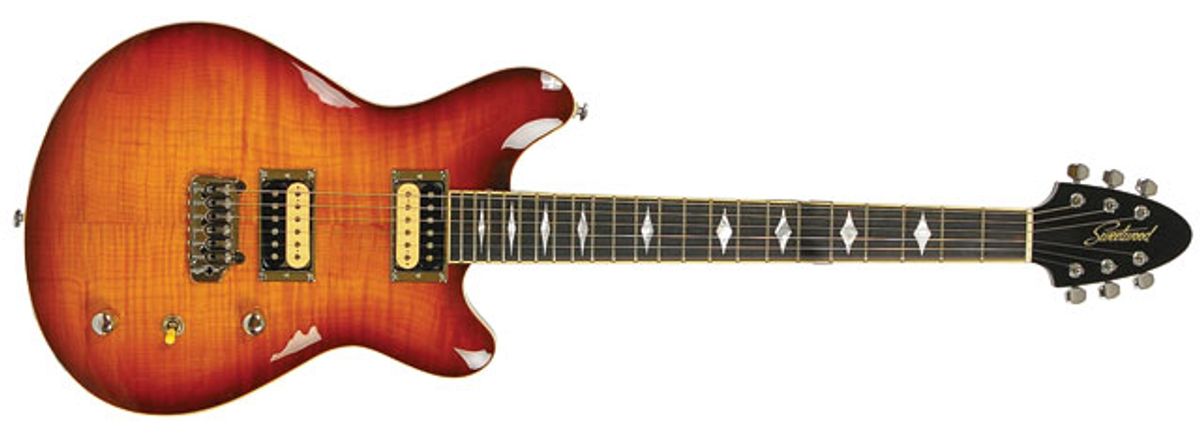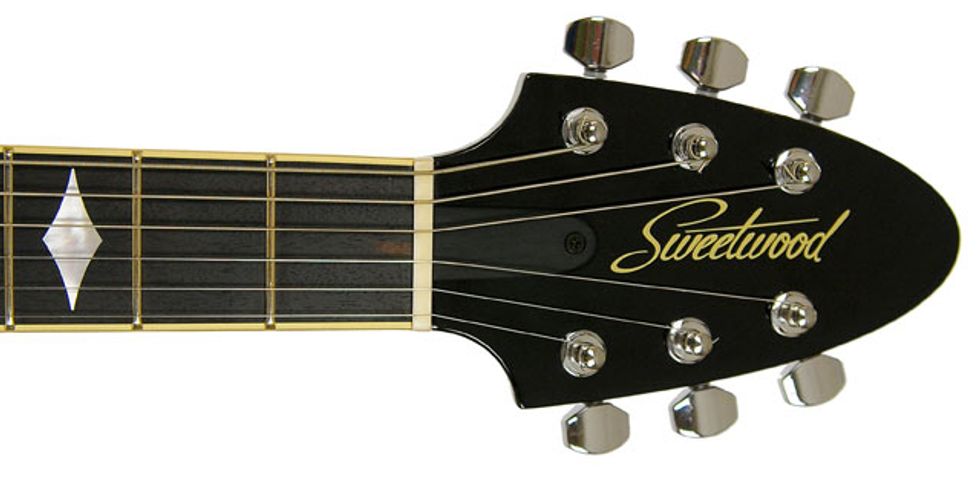
A well-built boutique take on the classic maple-mahogany combination.
| Download Example 1 Clean - Bridge and Neck Parallel |
|
| Download Example 2 Clean - Bridge Parallel |
|
| Download Example 3 Dirty - Bridge Series (Rhythm) |
|
| Download Example 4 Dirty - Neck Series (Lead) |
|
| Clips recorded through Marshall JMD:1. Deiay from Line 6 M12 used on example 4. | |
Like a Flash in the Sky
The Custom Comet we received for review has a tobacco-esque finish that Sweetwood calls Dark Honey Burst. And on the Custom Comet's flame maple cap it looks beautiful without being ostentatious. Overall the instrument's fit and finish is exceptional. If Sweetwood is going out of the way to stand out on the walls of a guitar shop, they succeed on the basis of their design and finish as opposed to any gloss or glitz.
With its double cutaways and a tummy contour, the Custom Comet is very comfortable and feels lighter than it looks. The multi-laminate set neck—composed of maple and mahogany, an ebony fretboard, 24 5/8” and a 12" radius—feels very fast. The Mother of Pearl diamond-shaped inlays add to the classy look of this California electric.
The Custom Comet’s neck is also notable for its unique asymmetrical design. The symmetry changes across the neck, being rounder by the nut and gradually becoming more asymmetric by the heel. It’s a subtle change and at first, I had no idea the neck was asymmetrical. It just felt good at all positions. Sweetwood got it right in making a neck that is both fast and extremely comfortable at all positions and fingerings.
Our review Custom came with Hipshot open tuners and Hipshot's tremolo bridge. The Hipshot tremolo is very smooth thanks to its use of ball bearings on its pivot points. And the tremolo was accurate with range on par with what you would find on a really good Fender or PRS tremolo.
The control layout might benefit from some minor re-configuration. Moving the volume knob and 3 way pickup selector switch slightly towards the neck would allow players better access for volume swells and switching without rubbing against the tremolo arm…and this is a guitar that really beckons you to use all the pickup options at your disposal. Sweetwood states these aspects of the design have been improved on the 2011 Comet lineup.

Bright and Brilliant
Though Sweetwood also lists Lollar pickups as an option for this model, the review unit shipped with a pair of zebra colored 'Wolftone Sweetwood' pickups. These scatter wound pickups feature Alnico II magnets and sounded very clean and bright, though the ebony fretboard and maple top lends itself to a brighter tone as well. I used a 100-watt Marshall to test the Comet, which certainly imparted some additional high –frequency characteristics. So I often ended up rolling off the tone knob almost a quarter turn to help tame the top end. It also appeared that the pickups had been adjusted so that they sat a little higher under the first three strings. By lowering the pickup and making some tone knob tweaks, I found a happy medium—bright but not too bright, and still detailed and clear.
The single volume and tone knobs each have a push-pull switch. The volume pot switches the neck humbucker from series to parallel, giving the guitar a nice clean shimmer that was more like a Stratocaster single-coil than Gibson P-90, but without the hum. The tone knob serves the same function for the bridge pickup. Issues with high end were more noticeable with the pickups set to parallel, which also caused a noticeable drop in volume compared to the pickups set in series. On an overdriven amp, the bridge pickup set in parallel mode sounded surprisingly Strat-like, especially considering the very Les Paul-like specs of the guitar. There is a lot of tonal diversity on tap with the Custom Comet. Series modes for both pickups sound very PAF-style fat with a very pure tone and with a wide frequency range. The combination worked great on clean amp settings. I didn't have to roll back the volume knob to get crystalline tones, but the guitar would distort with plenty of harmonic clarity when pumped through an overdriven amp. I especially enjoyed accessing the dark, rich tones of the neck pickup for lead lines that were delightfully clear and free of muddy blur.
The Verdict
The Sweetwood Custom Comet is a really well built guitar of exemplary sonic versatility. Only a few very minor (and disputable) design miscues detract from the overall playing experience, and Sweetwood says they intend to address each of them in the 2011 production models. The Comet is a bright guitar, but the tone can be massaged easily by taking advantage of the myriad pickup combinations. Comfort and feel are all absolutely top notch. And those are the things that a sub-standard builder cannot fake. Given the things Sweetwood got right, watching the company evolve should be quite interesting indeed.
Buy if...
you want a great feeling and playing electric with a superb neck and tone sculpting capabilities.
Skip if...
you make minimal use of tone controls or pickup switching when you play.
Rating...
|
Street $3250 (as reviewed) - Sweetwood Guitar Company - sweetwoodguitars.com
|


